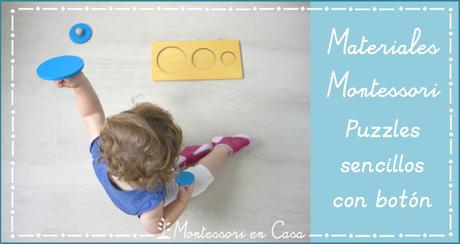
(scroll down for English)
Los puzzles sencillos con botón son ideales para niños a partir de un año. Están diseñados con formas geométricas sencillas y con los colores primarios y son perfectos como primeros puzzles porque aíslan la dificultad, al contrario que otros puzzles más complejos que son adecuados para niños más mayores.
El objetivo de estos materiales es favorecer la concentración, la coordinación ojo-mano y la discriminación visual, además de trabajar indirectamente el reconocimiento de formas y colores y el vocabulario. El "botón" permite al niño coger las piezas fácilmente y trabajar la motricidad fina, en concreto la pinza de 3 dedos, que más adelante será importante para la escritura.
Los primeros que se presentan son los puzzles individuales, de uno en uno y por orden de dificultad: círculo grande, círculo pequeño, cuadrado y triángulo. Más adelante se pueden ofrecer varios puzzles individuales a la vez, o pasar a los puzzles múltiples.
Presentación de los puzzles individuales:
- Colocar el puzzle sobre la mesa o la alfombra.
- Coger la pieza por el botón (con pinza de 3 dedos), decir el nombre de la forma y colocarla sobre la mesa o alfombra, debajo del soporte del puzzle.
- Volver a coger la pieza por el botón y colocarla en su lugar de forma cuidadosa y deliberada.
- Invitar al niño a utilizar el puzzle.

Presentación de los puzzles múltiples:
- Colocar el puzzle sobre la mesa o la alfombra.
- Coger las piezas una por una por el botón (con pinza de 3 dedos), decir el nombre de la forma (y el tamaño en el caso de los círculos grande, mediano y pequeño) y colocarlas sobre la mesa o alfombra, debajo del soporte del puzzle.
- Coger las piezas de una en una y colocarlas en su lugar, comprobando que no encajan en ningún otro lugar.
- Invitar al niño a utilizar el puzzle.
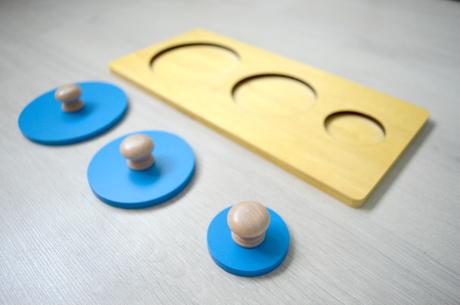
Recomendaciones:
- Como siempre, las presentaciones que hagamos para niños de esta edad deben ser cortas y sencillas, ya que su capacidad de atención todavía no es muy prolongada.
- Cuando el niño utilice el material es probable que no lo repita tal y como lo hemos hecho, pero no debemos corregirle.
- Si utiliza el material de una manera totalmente diferente tal vez no sea el momento adecuado para que trabaje con él, pero no le interrumpimos (siempre y cuando no lo esté maltratando), podemos dejarle terminar y volver a presentárselo más adelante.
Este material tiene un control de error muy evidente, ya que si el niño coloca una pieza en el lugar equivocado se dará cuenta de que no encaja (o si consigue encajarla como hizo Sara con el círculo en el soporte del cuadrado, después se dará cuenta de que el cuadrado no encaja en el soporte del círculo). Esto permite que el niño aprenda de sus propios errores sin necesidad de que nadie le corrija.
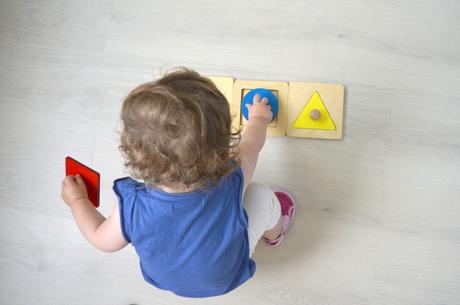
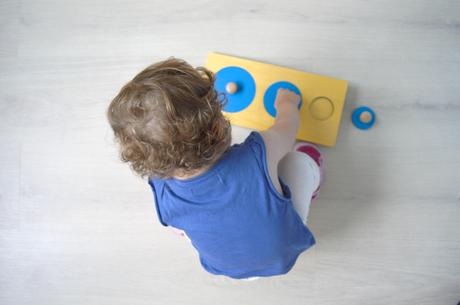
Si quieres aprender más sobre los materiales y actividades Montessori para la etapa de 0 a 3 años, échale un vistazo a mi curso online "Montessori de 0 a 3 años"
-----
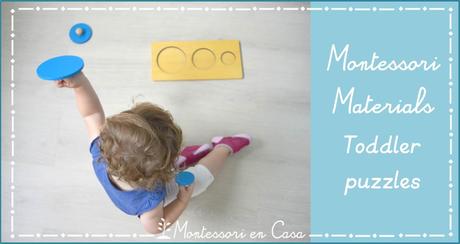
Montessori toddler puzzles are great for children from one year. They are designed with simple geometric shapes and primary colors and are perfect as first puzzles as they isolate the difficulty, unlike other more complex puzzles that are suitable for older children.
The purpose of these materials is to promote concentration, hand-eye coordination and visual discrimination, and indirectly work on recognizing shapes and colors and vocabulary. The "button" allows the child to grasp the pieces and work fine motor skills, specifically the 3-finger grasp, which later will be important for writing.
The first to be presented are the individual puzzles, one by one in order of difficulty: large circle, small circle, square and triangle. Later we can offer the child several individual puzzles at once, or go to multiple puzzles.
Presentation of individual puzzles:
- Place the puzzle on the table or carpet.
- Grasp the piece by the button (with 3-finger grasp), say the name of the shape and put it on the table or carpet, under the base.
- Grasp the piece by the button and put it back in place in a careful and deliberate manner.
- Invite the child to use the puzzle.
Presentation of the multiple puzzles:
- Place the puzzle on the table or carpet.
- Grasp the pieces one by one by the button (3-finger grasp), say the name of the shape (and size in the case of large, medium and small circles) and place them on the table or carpet, below the puzzle base.
- Grasp the pieces one by one and put them in place, making sure to check that they do not fit anywhere else.
- Invite the child to use the puzzle.
Tips:
- As usual, the presentations for children of this age should be short and simple, since their attention span is not very long yet.
- When the child uses the material she will probably not repeat as we did, but we must not correct her.
- If the child uses the material in a totally different way, then it might not be the right time to work with this material, but we do not interrupt her (unless she is going to damage the material or hurt someone), we let her finish and repeat the presentation some other day.
This material has a very obvious control of error, because if the child puts a piece in the wrong place she will realize it does not fit (or if she manages to fit it as Sara did with the circle on the base of the square, then she will realize that the square does not fit the base of the circle). This allows the child to learn from their mistakes without anyone correcting them.
Otros posts que te pueden interesar:
(Visited 1 times, 1 visits today)

